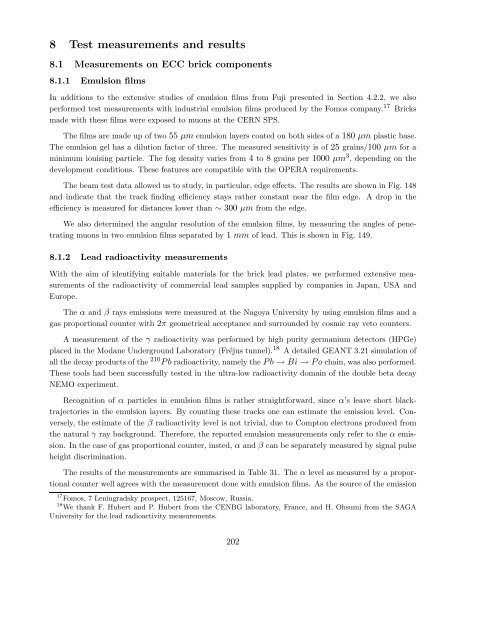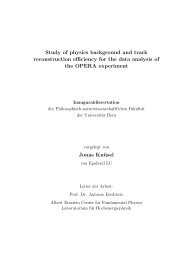Experiment Proposal - opera - Infn
Experiment Proposal - opera - Infn
Experiment Proposal - opera - Infn
You also want an ePaper? Increase the reach of your titles
YUMPU automatically turns print PDFs into web optimized ePapers that Google loves.
8 Test measurements and results<br />
8.1 Measurements on ECC brick components<br />
8.1.1 Emulsion films<br />
In additions to the extensive studies of emulsion films from Fuji presented in Section 4.2.2, we also<br />
performed test measurements with industrial emulsion films produced by the Fomos company. 17 Bricks<br />
made with these films were exposed to muons at the CERN SPS.<br />
The films are made up of two 55 µm emulsion layers coated on both sides of a 180 µm plastic base.<br />
The emulsion gel has a dilution factor of three. The measured sensitivity is of 25 grains/100 µm for a<br />
minimum ionising particle. The fog density varies from 4 to 8 grains per 1000 µm 3 , depending on the<br />
development conditions. These features are compatible with the OPERA requirements.<br />
The beam test data allowed us to study, in particular, edge effects. The results are shown in Fig. 148<br />
and indicate that the track finding efficiency stays rather constant near the film edge. A drop in the<br />
efficiency is measured for distances lower than ∼ 300 µm from the edge.<br />
We also determined the angular resolution of the emulsion films, by measuring the angles of penetrating<br />
muons in two emulsion films separated by 1 mm of lead. This is shown in Fig. 149.<br />
8.1.2 Lead radioactivity measurements<br />
With the aim of identifying suitable materials for the brick lead plates, we performed extensive measurements<br />
of the radioactivity of commercial lead samples supplied by companies in Japan, USA and<br />
Europe.<br />
The α and β rays emissions were measured at the Nagoya University by using emulsion films and a<br />
gas proportional counter with 2π geometrical acceptance and surrounded by cosmic ray veto counters.<br />
Ameasurementoftheγ radioactivity was performed by high purity germanium detectors (HPGe)<br />
placed in the Modane Underground Laboratory (Fréjus tunnel). 18 A detailed GEANT 3.21 simulation of<br />
all the decay products of the 210 Pbradioactivity, namely the Pb → Bi → Pochain, was also performed.<br />
These tools had been successfully tested in the ultra-low radioactivity domain of the double beta decay<br />
NEMO experiment.<br />
Recognition of α particles in emulsion films is rather straightforward, since α’s leave short blacktrajectories<br />
in the emulsion layers. By counting these tracks one can estimate the emission level. Conversely,<br />
the estimate of the β radioactivity level is not trivial, due to Compton electrons produced from<br />
the natural γ ray background. Therefore, the reported emulsion measurements only refer to the α emission.<br />
In the case of gas proportional counter, insted, α and β can be separately measured by signal pulse<br />
height discrimination.<br />
The results of the measurements are summarised in Table 31. The α level as measured by a proportional<br />
counter well agrees with the measurement done with emulsion films. As the source of the emission<br />
17 Fomos, 7 Leningradsky prospect, 125167, Moscow, Russia.<br />
18 We thank F. Hubert and P. Hubert from the CENBG laboratory, France, and H. Ohsumi from the SAGA<br />
University for the lead radioactivity measurements.<br />
202




